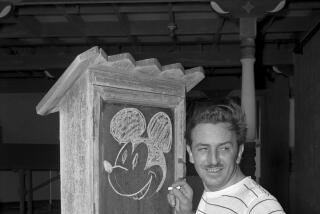Column One: Pack rat in the Mouse House
After Walt Disney died in 1966, his grieving staff sealed his office suite in Burbank, and even as work proceeded on âThe Jungle Bookâ there was anxiety that the companyâs past might be brighter than its future.
Four years later, those worries deepened as key executives approached retirement, including Waltâs older brother, Roy O. Disney. Thatâs why, in 1970, the company handed the key to Waltâs still-sealed office to a former UCLA research librarian named Dave Smith, who was sent into the chamber to learn its history.
âI didnât expect this to become my lifeâs work, but it did,â Smith, 69, said on a recent afternoon as he gave a tour of the Disney Archives, a massive collection spread across several in-house libraries and high-security warehouse space filled with Disney movie props, costumes, toys, art, animation, vintage theme-park gear and company publications.
It all began with the items that Smith found in Waltâs desk all those years ago.
âIt was an eerie thing to sit ⌠in his chair and count the paper clips in the drawer,â Smith recalled with a nervous chuckle. On the bookshelves, he discovered books and letters given to Walt by Upton Sinclair, Winston Churchill and C. S. Lewis, who inscribed one of his books of poetry with the words: âFrom one visionary to another.â
Friday, 40 years and a day after he was hired, Smith will announce his imminent retirement from a corporation that, as he put it, âreuses and returns to its past more often than any company in the world.â
His one-man history department has become a team of 12 that is busy going through hundreds of boxes of artifacts never fully cataloged. For years, there simply wasnât time for Smith to do anything more than grab, save and store. Now, with wide eyes and sometimes racing hearts, the younger preservation experts make almost daily discoveries of forgotten treasures.
On a recent afternoon at one of the archiveâs secret Glendale warehouses, Disney archive manager Becky Cline held up one recent find â a cache of storyboards and concept art for the 1964 classic â Mary Poppins.â
âThis hasnât been seen or touched since the movie came out, and itâs never been reproduced in any way,â said Cline, who will take over Smithâs title as official archivist after his departure in October. âThis is simply amazing stuff. And weâre going to get to show it to the world.â
When Disney President and Chief Executive Robert Iger got his first tour of the warehouse â which resembles the piled-high repository shown at the end of âRaiders of the Lost Arkâ â he knew the artifacts could be collecting more than dust.
Iger said this week that a fully dedicated Disney museum is a possibility and, when asked if the companyâs largely undeveloped industrial park in Glendale might be an option, he said yes. That parcel includes the old Grand Central Airport, a 1920s Art Deco relic that might be a candidate, according to some Disney sources, but Iger did not speak about that building specifically. At the least, Iger said, the company heirlooms will be displayed at the D23 Expo planned for next year in Anaheim or in a touring museum exhibit.
âIâm certainly intrigued by that idea, but weâre exploring multiple ways to do it,â he said. âIt could be that we end up in partnership with an existing museum, figure out ways to exhibit these great works at museums around the country or the world. It also could be that we create our own. Obviously, thereâs significant investment associated with that.â
Animating history
In its early years, Smithâs work was hardly revered in every corner of the company.
The research librarian got the job by being the right man in the right place at the right time. At UCLA, he had toiled on a Disney bibliography, and one day at the campus he overheard one of his bosses tell a Disney executive that the company should create its own in-house archive to hold on to its past. Smith was intrigued and offered his services, but no one in Burbank was sure what the job description could or should be.
Smith took a two-month leave from the Westwood stacks to poke through filing cabinets, unlock dusty storage rooms and interview Disney old-timers about long-gone colleagues and half-forgotten projects. Some staffers were puzzled or amused by the earnest young man scribbling down dates and names. In those days, the notion that youth entertainment deserved the permanent-record treatment seemed, well, goofy.
Smith wrote a proposal for an in-house archive and in 1970 officially joined the Disney payroll. The job was a mix of discoveries and dashed hopes in the early years. Some employees were reluctant to surrender caches that were so much a part of their history and, in many cases, connected to their current work. Others watched the parade of departing boxes with a smile.
âThey were just happy,â Smith said, âto get the office space.â
Smithâs work was far more than a paper chase. Within a few years of its founding in 1923, Disney was licensing its characters to companies of all sizes and sorts for toys, trinkets, apparel and bric-a-brac. The Disney corporate attitude toward this mountain of âoutsiderâ product was lack of interest or vague disdain. But the new archivist saw the Mickey Mouse wristwatches and Fantasia figurines as true artifacts, pieces of history.
âThis was a period before there were a lot of Disney collectors, so it was easier to find things and they didnât cost nearly as much as they would now,â Smith said, sitting in a Burbank office lined with rare Disney memorabilia.
âTake a look at this. I got this at the Rose Bowl swap meet for $18 in the 1970s,â Smith said, reaching for a small 1930s Donald Duck toy in a tiny, faded carton. âItâs in the original box, which is quite unusual. Itâs preserved in perfect condition and worth about $2,500 now.â
In the corporate corridors, Smith used to run into people who assumed he and his pesky school project would be gone within a few months. Roy O. Disneyâs ferociously loyal secretary fought his efforts to get access to her bossâ papers and effects. Finally, the archivist prevailed.
Among Royâs stuff was a ticket stub he kept in his top drawer. âItâs marked âNo. 000001,â Smith said, holding the first Disneyland ticket ever sold. âRoy bought the first ticket when the park opened 55 years ago. He paid $1 for it and then he kept it all those years right within reach.â
Hand it over
These days the archive is growing faster than ever. Iger issued an order in 2006 to all business divisions that if the archive wants something, it gets it âan acknowledgment of the growing value of movie props and Disney artifacts in the EBay era.
The team is now known around the company as the âRaiders of the Lost Archive.â
âWe did get a little bit of a reputation for being the people who came in and said, âOK, weâll take that and that and that âŚâ In a way, we are like, âWe have our warrant and weâre coming in,â â said Steven Clark, vice president of corporate communications, who also oversees the administration of the archives.
âWe try to be gentle, but we are taking things to be protected. And we are going to take them,â said Becky Cline, the archive manager.
So, despite turbulence, the team recently returned from Anaheim with three prized trophies from Disneyland: Melvin, Max and Buff, the three mounted animal heads that for decades serenaded visitors at the now-dismantled Country Bear Jamboree attraction.
Clark said that Iger has given the archives a budget that, for the first time, allows the team to acquire key Disney artifacts from private collectors. For instance, the carpet bag carried by Julie Andrews in âMary Poppinsâ may soon be back in the companyâs possession, though Clark wonât reveal details.
âWeâve found it,â he said somewhat cryptically. âWeâre working on it.â
Cline and Clark were sitting in Smithâs office on Disneyâs Burbank headquarters, chatting about their planned trip to Hawaii to gather props from the just-completed ABC television series âLost.â Smith smiled as he listened in.
âThey offered us the airplane â and I mean itâs a plane â but we had to say no,â Clark said. âSometimes you do have to say no. But we are going to take the interior.â
Smith got up and reached into a corner for something he wanted to share. It was much smaller than a commercial airliner and, really, much more impressive, and everyone leaned forward to inspect its yellowing pages.
âPeople told me all the time that Walt wasnât that interested in his own history and once he finished a film he put it away and never looked at it again. But when I inventoried his office, I found this,â Smith said.
He pulled out a 12-page sheaf with chunks of text interspersed with pencil drawings of a jaunty-looking cartoon character on a riverboat escapade.
Itâs âthe script for âSteamboat Willie,â the first Mickey Mouse cartoon,â Smith said as he offered the 82-year-old artifact for inspection. âHis chief artist, Ub Iwerks, did the drawings and Walt would have typed the text. I saw this and I knew Walt cared about his history, just like I do. Just like we do. And just like people always will.â
More to Read
Sign up for our Book Club newsletter
Get the latest news, events and more from the Los Angeles Times Book Club, and help us get L.A. reading and talking.
You may occasionally receive promotional content from the Los Angeles Times.









